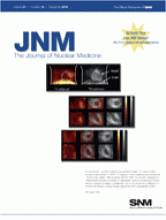
This month's issue of Journal of Nuclear Medicine Technology includes the SNM Practice Guideline for Breast Scintigraphy with Breast-Specific γ-Cameras 1.0 (1). This guideline concisely summarizes the clinical indications for the type of radionuclide breast imaging known as scintimammography, reflecting the current assessment of this technology by an SNM guideline committee assembled for this purpose. The guideline was approved in June 2010 by the board of directors of the SNM after almost 2 years of review of the previous SNM guideline for scintimammography as well as deliberations and publications by the American College of Radiology Appropriateness Criteria Panel on Breast Imaging, the American College of Surgeons Consensus Conference III, and the Institute for Clinical Systems Improvement.
The guideline appears approximately 38 years after a publication entitled “99mTc-Pertechnetate Scintigraphy as an Aid in the Diagnosis of Breast Masses,” which described the initial use of a γ-camera and a 99mTc radiopharmaceutical to identify and to assist in the differential diagnosis of breast masses either palpated or detected by mammography but with a degree of uncertainty about the potential malignant nature of the mass (2). The basis for localization of the tracer was never clearly defined, but it is likely that 99mTc-pertechnetate scintimammography represented simply “tumor stain” in the increased extracellular fluid space of a solid mass surrounded by adipose tissue. Subsequently, the technique was pitted against mammography as a screening agent, which was not the original intention. Not surprisingly, 99mTc-pertechnetate scintimammography was found to be less effective than mammography as a diagnostic tool and fell into disuse. In the 1990s, Tiling et al. reawakened interest in scintimammography using 99mTc-sestamibi as the diagnostic tracer (3). This radiotracer is lipid-soluble and in the intracellular environment binds to mitochondrial proteins. In the setting of a solid breast mass, and malignant tissue in particular, these features favor localization and therefore improve image quality. Piccolo et al. used a 99mTc-diphosphonate compound with a similar image acquisition technique and obtained favorable results (4). Localization was likely a reflection of a small molecule retained in the extracellular fluid space augmented by binding to microcalcifications.
Regardless of the 99mTc tracer used, breast image acquisition utilized a standard γ-camera. The best images were obtained in the lateral position with the breast dependant and as far from the thorax as possible since there was a considerable amount of radiotracer throughout the body. The substantial shielding in a traditional γ-camera resulted in masking several centimeters of breast tissue, and the bulky camera head made acquisition of other projections difficult.
The present guideline recognizes use of breast-specific γ-imaging that applies a small-field-of-view camera dedicated to low-energy γ-signal acquisition. This instrument has thinner shielding enabling acquisition of a greater area of breast tissue. In addition, the technique encourages, and the smaller camera head makes possible, acquisition of images simulating x-ray mammography: cephalocaudal, lateromedial, and mediolateral images. Thus, the breast-specific γ-camera makes possible the acquisition of images with positions comparable to mammography. There are multiple references to the excellent clinical results obtained with this technologic advance (5–9).
The guideline recognizes that other imaging modalities such as breast ultrasound and MRI may be useful in the assessment of breast masses and of women with concerns about breast malignancy who are not satisfied by traditional imaging techniques. The guideline also recognizes that other 99mTc radiopharmaceuticals such as 99mTc-tetrofosmin may be preferred by some physicians. Finally, the guideline draws attention to the recent development of the potential use of γ-probes as an aid in needle localization and biopsy.
Breast imaging has been and will likely remain a controversial diagnostic radiologic procedure. MRI is a sensitive but not specific tool to resolve areas of uncertainty. Scintimammography can provide additional information in uncertain cases, in women with dense breasts or breast prostheses in whom traditional mammography is often inadequate, and when there is a need to identify additional sites for further evaluation.
- © 2010 by Society of Nuclear Medicine
REFERENCES
- Received for publication October 19, 2010.
- Accepted for publication October 26, 2010.







